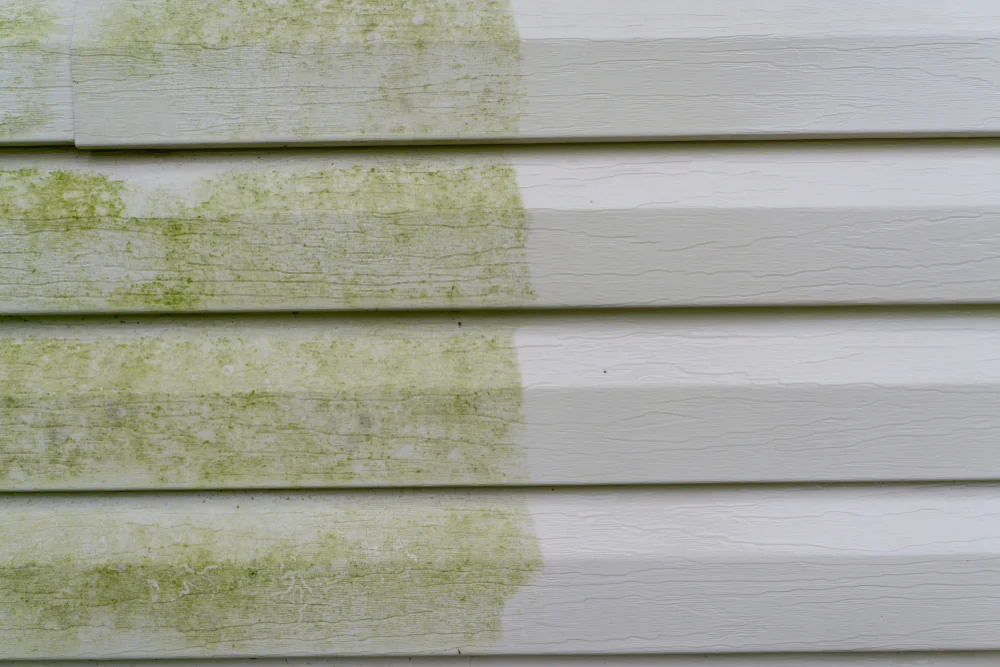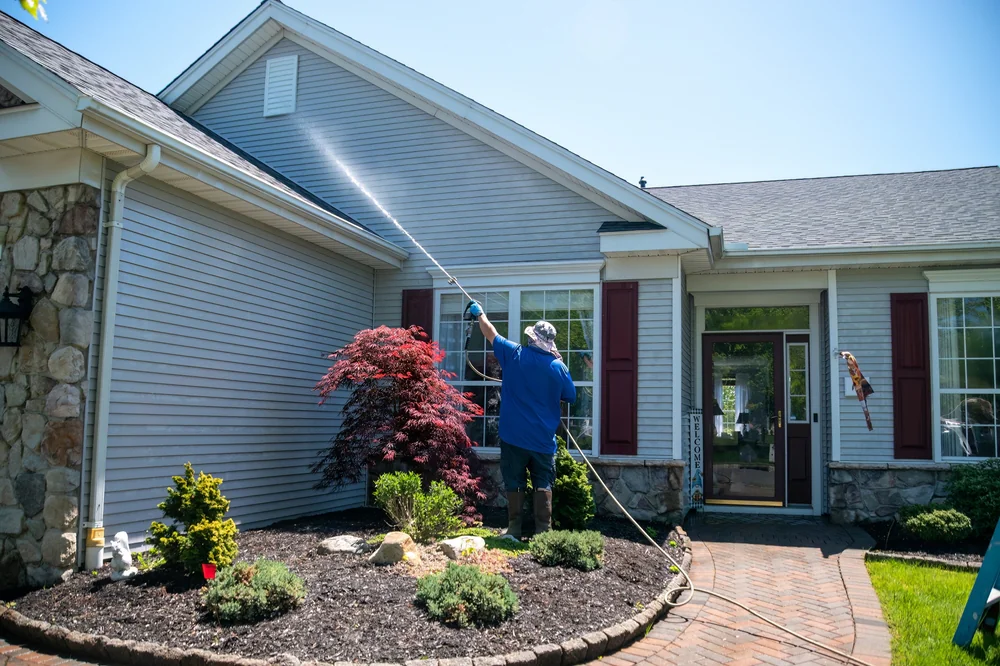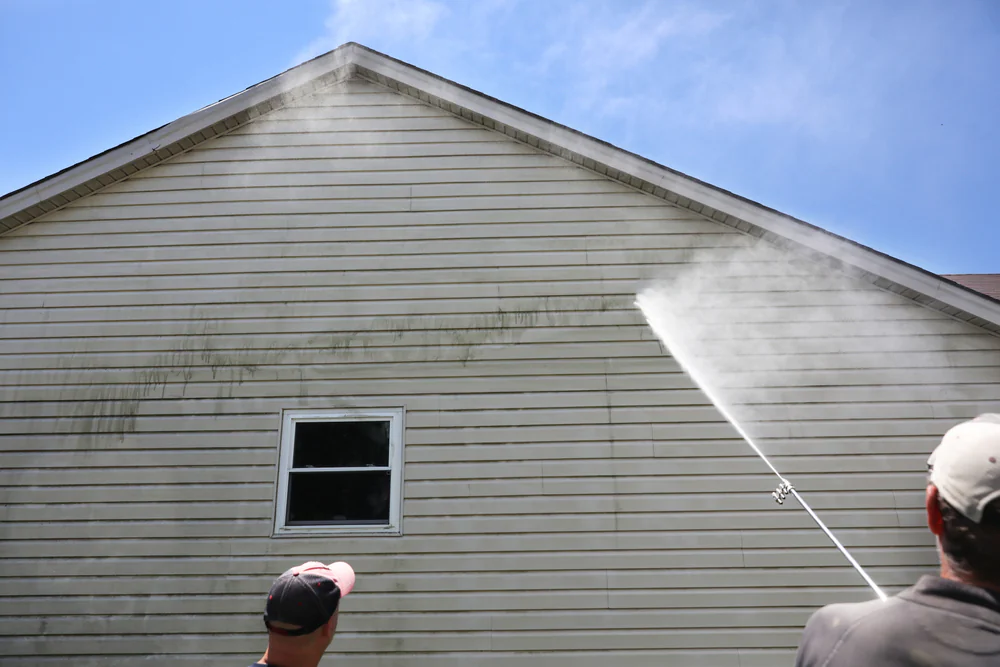Power washing before painting isn't optional in Colorado's harsh climate—it's the difference between paint that lasts and costly do-overs.
Share:

Summary:
Paint adhesion is pure science. Your paint needs to form molecular bonds with the surface, but Colorado’s environment creates multiple barriers to this process. Dust, pollen, oxidation, and microscopic debris create a layer between your paint and your siding.
Paint that was applied over a surface that wasn’t properly prepared — such as a wet, shiny, or dirty surface is destined for failure. In Colorado’s climate, this isn’t just about aesthetics—it’s about protecting your investment from extreme weather conditions.
Poor texture arises from poor preparation, and it’s usually the same culprit – a dirty or gritty wall. Some inexperienced painters get so excited to start their projects that they don’t even consider cleaning first. This oversight costs homeowners thousands in premature repainting.

Colorado is known for its unpredictable weather. A warm, sunny afternoon can quickly turn into a chilly evening. These rapid temperature changes cause building materials to expand and contract, which puts stress on the paint and can lead to cracking or flaking. When paint can’t keep up with the movement of the underlying materials, it can lose its grip, exposing your home’s surfaces to moisture and other damage.
But temperature isn’t your only enemy. Colorado’s higher elevation means the sun’s UV rays are more intense. These rays can break down the pigments in paint, causing colors to fade and lose their vibrancy. South- and west-facing walls are particularly vulnerable to this type of damage. Faded paint doesn’t just look dull; it also loses its protective qualities, leaving your home more exposed to weathering.
Your paint needs every advantage to survive these conditions. Starting with a contaminated surface is like building on quicksand. And when temperatures fall below 40℉, the paint takes too long to dry and cure. This also can cause bubbling and cracking, poor adhesion, and a short life span of the paint job.
The solution starts with understanding that Colorado homes need more than standard preparation. Power washing removes the invisible barriers that cause adhesion failure, giving your paint the clean foundation it needs to bond properly and withstand our challenging climate.
Skipping power washing might save you a few hundred dollars upfront, but it often leads to complete paint failure within 2-3 years instead of the expected 7-10 years. The median home sold price in Larimer County was $549,552 in June 2025, making every maintenance decision crucial for protecting your investment.
Consider the math: professional power washing typically costs $300-600 for most homes, while a complete exterior repaint ranges from $8,000-15,000. When paint fails prematurely due to poor preparation, you’re not just paying for new paint—you’re paying for additional scraping, priming, and often repairs to surfaces damaged by peeling paint.
We’ve seen homes that had not been painted in 15 years, were dirty, peeling and chipping. After we completed a thorough job of washing, refurbishing and painting, these homes looked brand new. This transformation illustrates what’s possible when proper preparation meets professional execution.
The hidden costs extend beyond money. Failed paint exposes your siding to moisture infiltration, UV damage, and temperature extremes. What starts as a cosmetic problem becomes a structural issue requiring expensive repairs. Power washing before painting prevents this cascade of problems by ensuring your paint can do its job—protecting your home’s exterior from Colorado’s demanding climate.
Want live answers?
Connect with a LF Rosa Painting expert for fast, friendly support.
Professional power washing for paint preparation goes far beyond renting a machine from the hardware store. The process requires understanding pressure levels, cleaning solutions, and timing to prepare surfaces without causing damage.
Providing pressure washing as part of our painting service ensures that your paint job bonds well and lasts for years. That means lasting protection and curb appeal! This integrated approach ensures compatibility between cleaning and coating processes.
Different surfaces require different approaches. Vinyl siding needs lower pressure than concrete, while wood requires careful attention to grain direction and moisture content.

Professional power washing equipment operates at precise pressure levels with hot water capabilities reaching 250 degrees Fahrenheit when needed. This isn’t just about power—it’s about control and versatility.
A common misconception in the washing industry from a customer’s perspective is the fact that pressure washing can and will damage property and surfaces. The answer is yes, pressure washing can damage surfaces when performed by untrained and uneducated operators. Techniques such as soft washing, hydroscrubbing/surface cleaning, mold & mildew removal, oil stains, paint prep and more all should be done with special techniques that will not harm the surface.
We understand how to adjust pressure based on surface material, age, and condition. We know when to use hot water for grease removal, when soft washing is appropriate for delicate surfaces, and how to protect landscaping and windows during the process.
The timing matters too. Washing surfaces with pressure before painting is a great idea to get rid of dirt, mold, and loose paint. Doing this helps the new paint stick better and last longer. But surfaces must dry completely—typically 24-48 hours in Colorado’s dry climate—before painting can begin.
This drying period isn’t just about surface moisture. It allows the cleaning process to fully remove loosened contaminants and ensures the surface reaches optimal conditions for paint adhesion.
In Colorado, the best time of year to paint your house is between late April and early October. Temperatures between 50-70 degrees Fahrenheit are going to be the most optimal. That being said, there is some leeway on temperature, with about 10 degrees on both sides of the spectrum.
Power washing should occur 2-7 days before painting, depending on weather conditions and surface type. This window allows complete drying while preventing new contamination from accumulating. In Colorado’s dusty environment, waiting too long between washing and painting can compromise the benefits of cleaning.
Weather monitoring becomes critical during this period. Any sort of precipitation can introduce problems when painting a home’s exterior. If it rains while your home is being painted, the paint can potentially wash off if not dried fully. It’s also not ideal to paint when the surface is wet, as the paint won’t stick properly.
We coordinate power washing and painting schedules to optimize conditions for both processes. We understand Colorado’s weather patterns and plan accordingly, often having backup dates ready for weather delays.
The investment in proper timing pays dividends in paint performance. Prep work is key to ensuring a durable paint job, especially in Colorado. This includes cleaning surfaces, repairing cracks, and applying primer. A high-quality primer helps the paint adhere better and provides an extra layer of protection against the elements.
The difference between amateur and professional power washing becomes evident in the results. Professional contractors understand the connection between surface preparation and paint longevity, treating power washing as the foundation of a successful painting project rather than just a cleaning service.
One recent client shared: “Excellent paint job and quality of work, we highly recommend Rosa Painting! Their expertise and professionalism from initial consultation to final walkthrough made the process seamless. Luis and his crew paid attention to detail, cleaned up thoroughly each day, and finished the job on time.”
When your paint investment depends on proper preparation, trust L F Rosa Painting to deliver the comprehensive approach your Larimer County, CO home deserves.
Article details:
Share:
Continue learning: